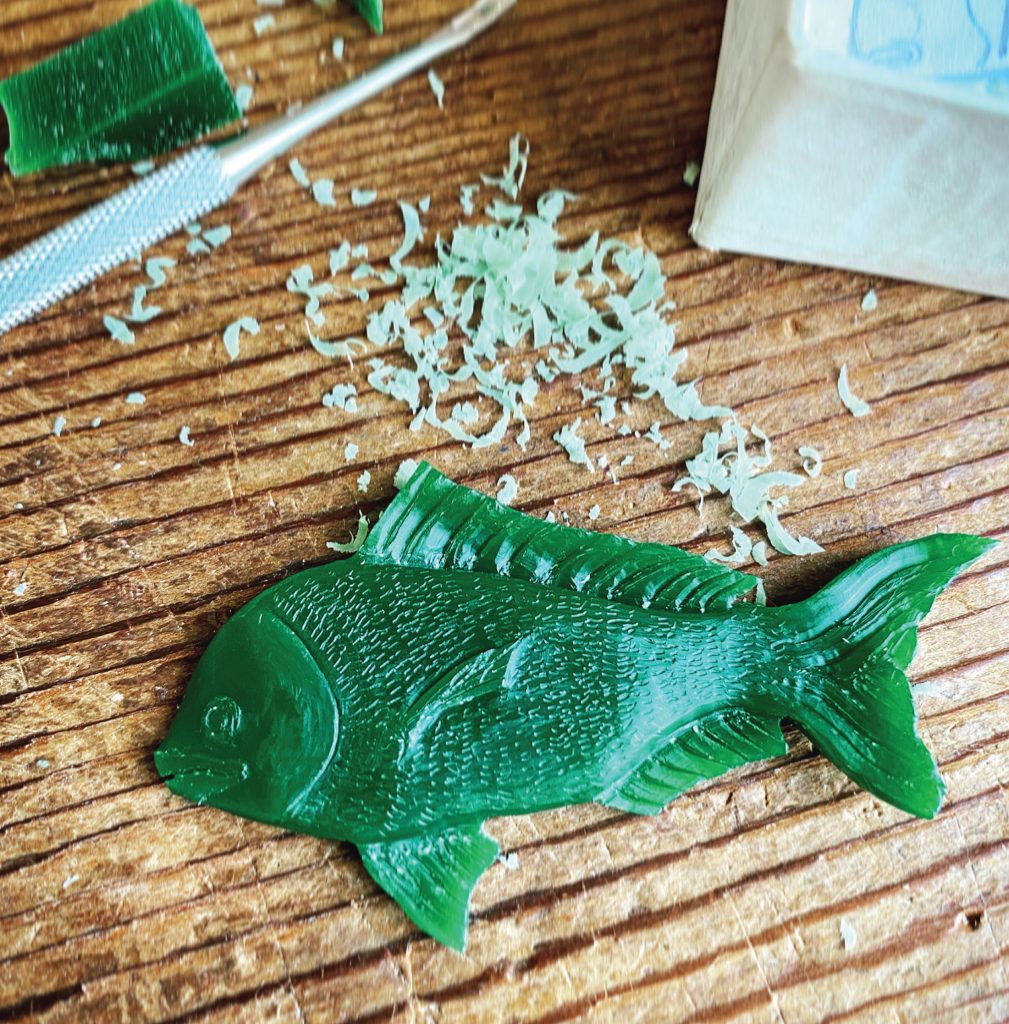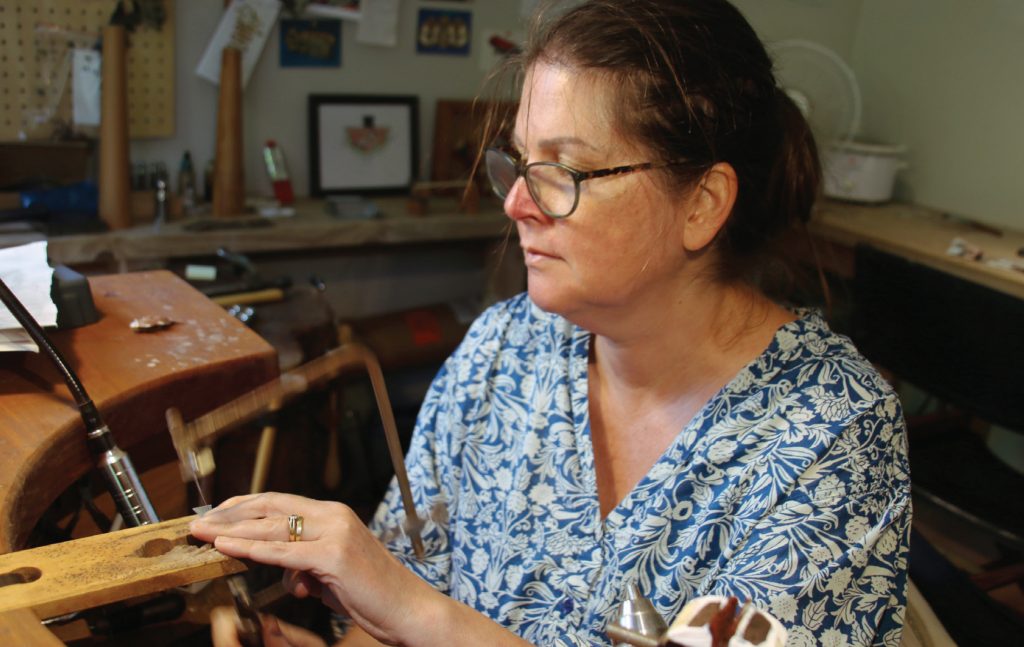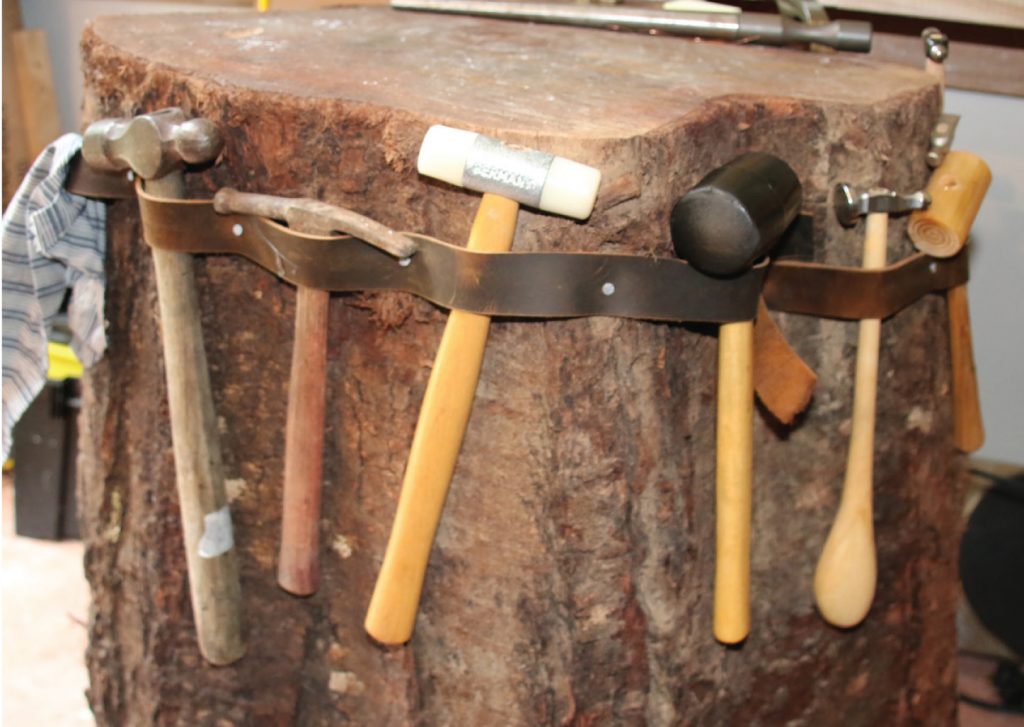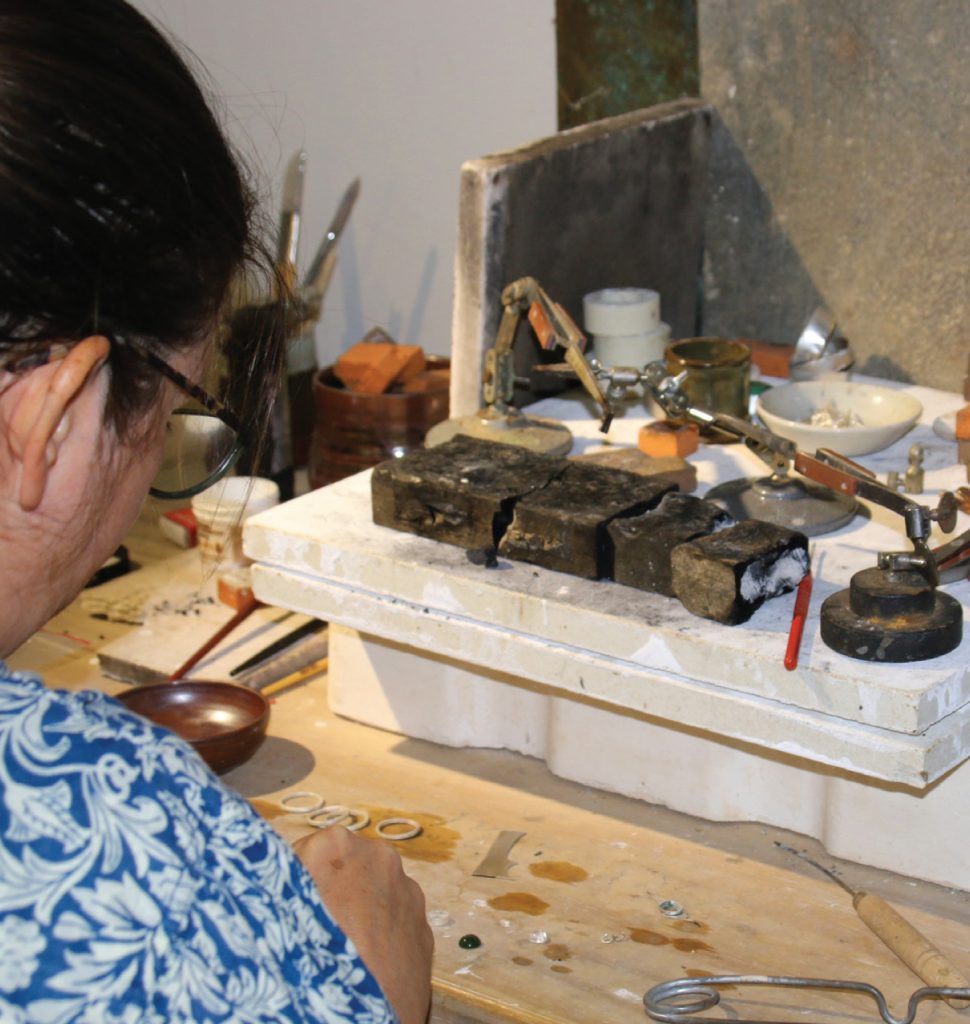



Waiheke silversmith Jenny Mason talks to Helen Vause about her ancient craft .
This article was first published in The Waiheke Weekender on 19 January 2023
It was the touch of bling in the wealthier drawing rooms of the world. The silver serve ware brought a look of luxe to the posher sideboards and it was the sparkle that everyone who had the wherewithal to buy it, wanted. Silver tea pots, coffee pots, and much more kept the silversmiths of the day very busy turning out their desirable wares. Alongside its more expensive sister gold, silver was also a precious metal that had appeal for adornment. By the mid1800s, Americans couldn’t get enough of the distinctive jewellery the Navajo people had started making, often worked with turquoise and introducing a whole new style to the fashion and lust for the gleaming metal.
Silversmithing is an ancient craft and those who practice it are now few and far between. But Waiheke’s Jenny Mason was captivated by it in her teens and has immersed herself in learning about working with this precious metal, producing beautiful pieces of jewellery for local galleries on the island and clients far beyond.
On any day she’s likely to be down in her little studio, tucked under a house up one of the island’s quiet little bushy roads far from any disturbance. It’s her happy place but finding her way there through the years of parenting and commuting to city jobs, has taken a while.
She’s been steadily gaining a reputation for her work since she found the space and the time to seriously hone her silversmithing skills in 2019. Established in her now regular practice of working with metal, she disappears into another world of intense concentration, a sense of creative purpose and sometimes burns her fingers!
It’s her passion. She is enchanted by the alchemy of working with silver and the processes of it all, where medieval chemical science mixes with pure magic.
Her first close encounter with silversmithing was 30 years ago at university in upstate New York. British born Jenny’s American parents had taken her back to the United States for a taste of life in their home country in her teens, and she’d enrolled at the private liberal arts, Skidmore College in pretty Saratoga Springs. The university had a metals studio and offered many courses in working with precious metals for creative and artistic pursuits. Jenny took as many of these courses as she could, considering she was majoring in English. “At that time I was not ready to follow my love of making things with silver and try to make a career of it.” But the experiences in the metal studio at Skidmore were firmly embedded in what had already been a highly creative life.
It was no surprise to anyone that she’d have such a strong desire to follow a creative path She’d grown up in Britain in a family where there were always works in progress at the hands of people with a wide range of creative talents. Her father tinkered with electronics but also loved to make miniatures. Every Christmas and birthday, Jenny recalls there’d be a tiny new piece of furniture for his children to embellish their dollhouses.
Her mother was an academic in medieval literature and could make period costumes. One of her grandmothers was a whizz at needlepoint and the other had a fascination with applique, creating beautiful fabric pieces. Her younger sister also went to Skidmore and on recent travels Jenny was delighted to hear her lecturing on jewellery in Paris.
At college in the beautiful American resort town, Jenny had been able to explore her strong creative drive, but she had not been won over by the way of life in that country. She’d also met her future husband, fellow student Paul Mason, who also happened to be an Englishman. The pair returned to the United Kingdom together, and Jenny left the world of the metal studio behind. She found work at first in newspapers, putting together the pages that covered the regions. It was highly engaging, covering the booming television industry and all its drama both on and off screen. The television world looked pretty exciting from a newspaper office, and she enrolled at the prestigious Goldsmiths, part of the University of London, to do a Master’s Degree in television production.
She laughs at the memory of diving into that world and finding herself in the wrong role in a very busy picture. “l found working in that industry very overwhelming. It’s a job that just consumes all of you and your life. It just wasn’t the life for me. “
Restless and looking for a change of direction, Jenny and Paul, like plenty before them, were attracted by talk of faraway New Zealand and wondered if it might be the place for them and their cats. One trip convinced them to return to the UK, pack up their lives and move here. They found work in South Island ski fields, and Jenny earned her living flipping burgers. They set off exploring the country, looking for just the right spot to settle, tootling around in their modest vehicle and sleeping mostly under the stars in their tent. With them were their beloved cats Robyn and Wilkins “We wouldn’t have left them behind in the UK. They were like our children.”
Jenny and Paul carried with them tales of the wonders of Waiheke picked up from other travellers. When the day came to cross to the island it was pouring with rain. A quick glance at their map suggested Stonyridge Vineyard was an attraction within walking distance of the ferry terminal at Matiatia. Bad idea! Soaked, nursing blisters and disappointed, they limped back over many kilometres to the ferry. “I told Paul I couldn’t understand what anyone saw in the place.” But they gave the island another chance. It was when camping in Whakanewha Regional Park when they awoke to the realisation that they’d found their paradise. The park ranger wasn’t pleased to discover the startled, whiskered Misses Robyn and Wilkins, and sent the campers packing. Jenny and Paul settled on Waiheke in 1998, along with Robyn and Wilkins.
Paul taught on the island, and for some years Jenny commuted to work in the city. They raised children and life got in the of Jenny having the headspace, the time, or the place to get into making silver jewellery. But luck, the grapevine and the small scale of the community led her to the studio of Waiheke ‘s jeweller turned sculptor Paora Toi Te Rangiuaia. He gave her bench space and generously shared his wisdom and techniques.
Although it would be years before she’d get to making silver jewellery in her own studio, the time with Paora was valuable and encouraging. Although she’d developed steady business in graphic design work that she continues with today, in 2019 she was ready to devote more of herself to her other love and get back into silversmithing. She set up her little studio and built up her supplies of tools like hammers, tiny pliers, and magnifiers. She crafted work surfaces to hammer and shape on, and got down to business, as the rest of the country wobbled through the lockdown days.
And the world loved what she was hand crafting in silver, sometimes with a touch of gold or stones in her little studio. Jenny Mason was a finalist in the Waiheke Community Art Gallery Small Sculpture Awards. She now sells her work at the gallery and is part of the island’s Space Gallery collective. Her work is available in a city gallery, and she undertakes commissions for people who know and love her work. “The most unusual thing I’ve been asked to do is incorporate a pig tusk into a silver pendant,” she chuckles.
Her inspiration comes from within and from all around her, with nature reflected in many of her pieces. Sometimes it comes from just outside the studio window from the sights that are such a common feature of life in the bushier enclaves of the island. The ivy climbing up a water tank, she says is an image that begged to be recreated as jewellery. So, she formed ivy leaves by hand into wax for a detailed and delicate mould, that could be sent away tor casting in sterling silver.
She points out that many jewellers and artists respond to nature and its flora and landscapes in this way, using it as the basis of new work. She’s made work from the striking shapes of the Hauraki Gulf, notably Rangitoto Island. She crafted a landscape shaped pendant with relief work in silver depicting the island’s familiar form, framed with a narrow gold border.
Often, she wants to work with found objects that are easily sourced around the is land’s beaches; baby scallop shells and sea glass often make their way into her work. She says after a bit of fossicking for “just the right bits” She’s found the island coastline facing the city has the best selection. ‘”As well as being pretty, seagrass is a piece of history. A lot of it is glass from the bottling plants of years ago.” And while hopefully boaties are no longer flinging their drink bottles into the gulf, those that did this in earlier times guarantee a running supply of different coloured sea glass pieces for keen eyed artists like Jenny.
Silversmithing by hand is slow, painstaking work and often it will take a couple of days to make one piece, slowly coaxing silver sheets and foil to do what she wants. Sometimes, as she says, it involves ‘bashing away’ with one of her many little specialised hammers. Sometimes it can involve using tiny long legged pincers and magnifiers to execute detail where fingers would be too clumsy and human eyesight would just not be adequate for the task. It involves using sharp and potentially dangerous tools and it can call for using a heat source at alarmingly high temperatures to soften silver, making it more malleable for crafting. And yes, she laughs, even with the greatest of care there can be plenty of mishaps and days going home with ‘munted fingers.’
Then there are the days when whatever is in the mind’s eye just isn’t working for the artist and the project has to be reworked or abandoned after hours of trying. “Sometimes when you’re working on a piece, it just doesn’t work out as you have planned. You just must recognise the right time to give up on something, and not keep on at it wasting time and materials. It’s a judgement thing.” And silversmithing requires absolute attention and focus, perfecting the finish and detail that makes her work so attractive to the growing number of people wanting to wear it.
“lt’s that quiet focus, almost a meditative state where I can become totally absorbed for hours and hours in the work. That and the whole creative process is what I love and find so rewarding about being able to do this at this time in my life. I just love to be here, working in this studio.” She adds that it’s also a direct contrast to the state-of-the-art computer technology involved in graphic design work, that was for so long her bread and butter day job.
She’s known among the silversmithing community for her skill and for her problem solving approach. Recently she was able to employ other skills to put together a ‘how to’ video condensing a long, tricky process into something for other jewellery makers to follow.
Sometimes she shares the downstairs space with husband Paul, an author of books for children. But mostly she works alone, in her own world of precious metals and creativity. Lately she has become very interested in and absorbed by a process known as Keum boo. This is an ancient Korean technique used to apply thin sheets of gold to silver or bonding gold foil onto silver The gold foil is ‘horribly expensive’ and the process, not surprisingly, is tricky and painstaking, calling for a high level of concentration and an environment free of airborne particles that might float onto the work and spoil it. There’s the potential for plenty to go wrong when she’s quietly at work on her latest Keum boo silver and gold pieces — so how does she control the environment and set herself up for success? “Oh I shut the studio door and I’ve got a sign that says ‘Don’t come in. Working with gold foil.“
